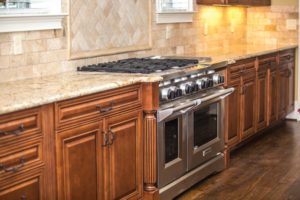Kitchen Remodeling

Remodeling a kitchen may seem like a walk in the park, but it can be quite the hassle. The kitchen, being the heart of your home, is quite special so the decision and implementation should not be rushed. Proper planning and research should go into the process. Remodels also work great in increasing the resale value of a home, probably the reason why they are most popular.
On average, homeowners spend about $21,729, and smaller projects may cost much less. Some of the work involved is upgrading the sinks, refacing cabinets, installing custom cabinets, painting walls, installing tile back splash, tile or hardwood floors, high-end appliances, granite counters, etc.
To start with, find a contractor you trust and work with him to develop a plan that suits your preference and your budget. If you are working on a low budget, consider doing most of the work yourself and then get a professional for some of the other projects. It is a good idea to also purchase most of the materials yourself before calling them in. Although some contractors may be able to buy the items at wholesale prices, others will charge for the purchases. Therefore, save time by purchasing them before hand to take care of the labor costs only.
Don’t forget to sign a contract with detailed information that includes the timelines and the cost estimates.
Factors to Consider in Kitchen Remodeling
- Budget
You need first to have an idea of what you would like to achieve with your kitchen. Instead of replacing your cabinets or appliances, you should consider refacing or refinishing them. It will be more economical and less time-consuming for you.
Budget determines the desired kitchen plan, materials, contractors, etc. Failure to plan could lead you into massive debts or prevent you from completing the project. On average, $45,000 is needed for a major remodel, $25,000 for a mid range remodel and $5,000 for a low-cost remodel. Set aside some extra money for unexpected costs or problems that could arise during the remodel. Labor costs should also be included in the budget if you hire a contractor for some of the work.
- Lifespan
The general rule is that 5 to 15 percent of your total home value is what you should spend on the remodel. It is not necessary to spend too much on your remodel especially if you are planning to leave shortly. However, if you will be living in that house for a long time to come, then, by all means, splurge on your kitchen.
Elements of Kitchen Remodeling
- Countertops
It is probably the first thing one sees when you enter the kitchen. There is a wide array of materials available in the market. Tiles require a bit of maintenance with time, Formica and concrete are great if you are looking for something subtle and affordable while Corian and granite are the most expensive because of their durability. Other common materials used include wood, bamboo, metal, recycled glass, laminate, etc.
- Appliances
Appliances make up a significant part of the kitchen, and you can choose from budget appliances, high-end appliances, energy star or custom built appliances. The function of your particular device will contribute to your decision.
- Cabinets
Along with countertops, cabinets make a lasting impression so they should not be ignored. Depending on your budget and desired outcome, you can choose between stock, custom, semi-custom, refaced or refinished cabinets.
- Flooring
When selecting a flooring design, keep in mind the cleaning and maintenance involved. Kitchens are active work stations and are therefore prone to stains, dirt, etc. The expensive options such as tile, granite, and wood require more maintenance although they increase the value of your home. Linoleum and Vinyl tend to be cheaper options. Others alternatives include stone, cork, laminate, etc.
- Electrical
Changing the kitchen’s design might mean moving outlets and fixtures. An electrician will guide you best on how to go about it.
- Plumbing
Try not to move the plumbing elements as this might cost you big time and disrupt your budget. You would need to install additional pipes, connect them to the main line, hire plumbers and get permits from the city. Unless this is necessary, avoid it.
- Gas Lines
In most remodels, moving the cooktops and ovens is not required. This might be because of the associated high costs involved in moving and running additional gas lines.